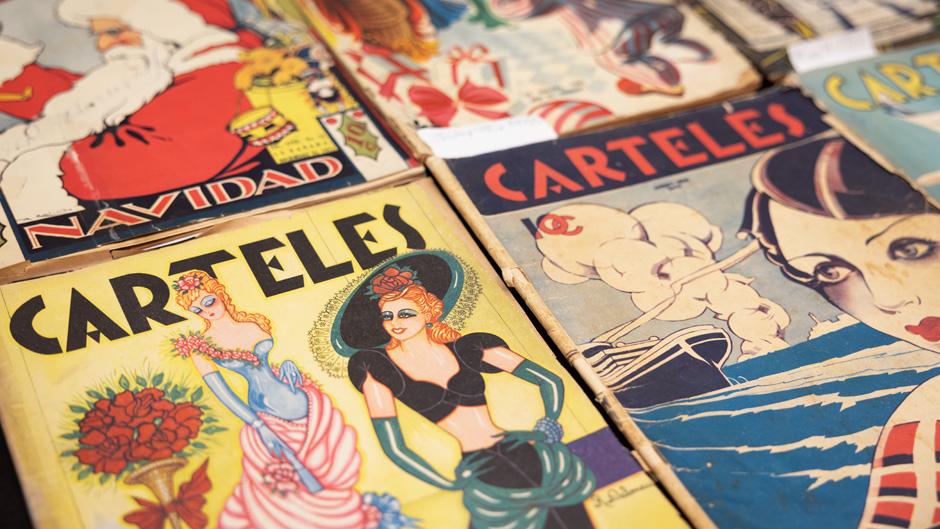Dozens of University of Miami faculty members, dignitaries, and community members gathered on Friday at the University of Miami Libraries’ Cuban Heritage Collection to commemorate the 20th anniversary of the Roberto C. Goizueta Pavilion in an event called “Hacia el Futuro.”
The pavilion, which opened in 2003, is named after Cuban-born Roberto C. Goizueta, the former CEO of The Coca-Cola Company. Its elegant foyer features marble floors and a colorful mural by Cuban American artist Humberto Calzada that resembles an old Havana sitting room.
Roberto S. Goizueta, the oldest son of the Coca-Cola magnate and director of The Goizueta Foundation, shared some sentiments with the festive crowd.
“On behalf of the Goizueta family, we congratulate the University of Miami for its dedicated work over the last 20 years to preserve Cuban heritage through the Cuban Heritage Collection,” he said. “I know that my father, Roberto C. Goizueta, would be proud to have his name associated with the most important body of resources on Cuba and the Cuban diaspora outside of the island,” he added.
“My father used to say that his story boils down to a single inspiring reality: that a young immigrant could come to the United States, be given the chance to work hard and to apply his skills, and ultimately be given the opportunity to lead,” he continued. “Our hope is that the life and legacy of my father, whose leadership at The Coca-Cola Company allowed him the resources to give back to the community, would serve as an inspiration for future generations of Cubans and that the University of Miami would continue its work over the next 20 years to honor those future generations.”
Jeffrey Duerk, executive vice president for academic affairs and provost, said that he had been with the University for only a month when he learned about the plight of the Cuban people and the struggles of the exile community during a meeting with Cuban American community leaders.
“Their passion had a profound impact on me,’’ he said. “And I quickly realized how significant the Cuban Heritage Collection was not only to the scholarly mission of our University but also to the people whose stories have been entrusted to us to preserve and to learn from,” he said.
“The CHC, a crown jewel of the University of Miami and its libraries, has had quite a historical trajectory,” said Charles “Chuck” Eckman, dean of libraries.
“It is an amazing story, rooted in the extraordinary efforts of five Cuban American librarians, all women,” he added. “The Goizueta family and The Goizueta Foundation recognized this as well as that such important scholarly study requires a special space in which to interact with materials. The pavilion has had a remarkable growth and impact."
The continued support of The Goizueta Foundation has greatly enriched the CHC, which is the largest collection of Cuban and Cuban diaspora documents, books, maps, artists’ books, and newspapers in the United States. It also has an impressive number of business and organizational records, personal papers, and letters from Cubans—including world-known musician Paquito D’Rivera to Martha Flores, the beloved Miami radio personality.
The collection’s contents are sought by scholars, students, and community members for its wealth and depth. This includes material from Cuban ethnologist Lydia Cabrera; former Cuban presidents Tomás Estrada Palma, Gerardo Machado, Fulgencio Batista Zaldivar, and Carlos Prío Socarrás; the Cuban Refugee Center records; and an extensive collection of personal correspondence and manuscripts from Cuban and Cuban American leaders.
“We are profoundly grateful to the Goizueta family for the gift that created this marvelous pavilion that greets our visitors and for all their considerable gifts to the Cuban Heritage Collection,” said Amanda Moreno, interim Esperanza Bravo de Varona chair and director of the Cuban Heritage Collection.
One of the most valuable gifts the Goizueta family has bestowed onto the CHC is the funding of The Goizueta Foundation Graduate Fellowship Program. This initiative has funded 131 fellows to engage with the material in the archives.
One of those fellows was Michael J. Bustamante, associate professor of history and the Emilio Bacardi Moreau Chair at the University. His extensive research at CHC toward his doctoral dissertation was crucial to what became his first book, “Cuban Memory Wars.”
“Quite literally, I owe the CHC my Ph.D., my first academic position, and now, my role here at the University of Miami,” Bustamante said. His research and experience will help launch an interdisciplinary undergraduate program in Cuban Studies that will complement ongoing studies and research at the University.
The University of Miami has long been an important center for the study of Cuba in the United States. Ties to the island date back to the early period of the University’s history. In 1926, the Miami Hurricanes played a football game against the University of Havana and won, with a score of 23-0.
In this spring semester, Bustamante will launch the minor in Cuban Studies, teaching courses including one called the “History of Cuba.” A great number of University professors presently conduct research on the island and teach courses which include the history, politics, architecture, art, and marine life of Cuba. Many of these courses about Cuba will be offered to students wanting to enroll in the minor.
The CHC has also become famous for bringing together some of the best minds on the topic of Cuba. Every two years it hosts the “New Directions in Cuban Studies Conference,” which attracts many scholars including a good number of Goizueta fellows who present their research to a wide audience.
“As a result of its many CHC programs, the collection now more than ever, is not just a repository of information but a producer of new knowledge about Cuba’s past, present, and even its possible futures,” said Bustamante.

